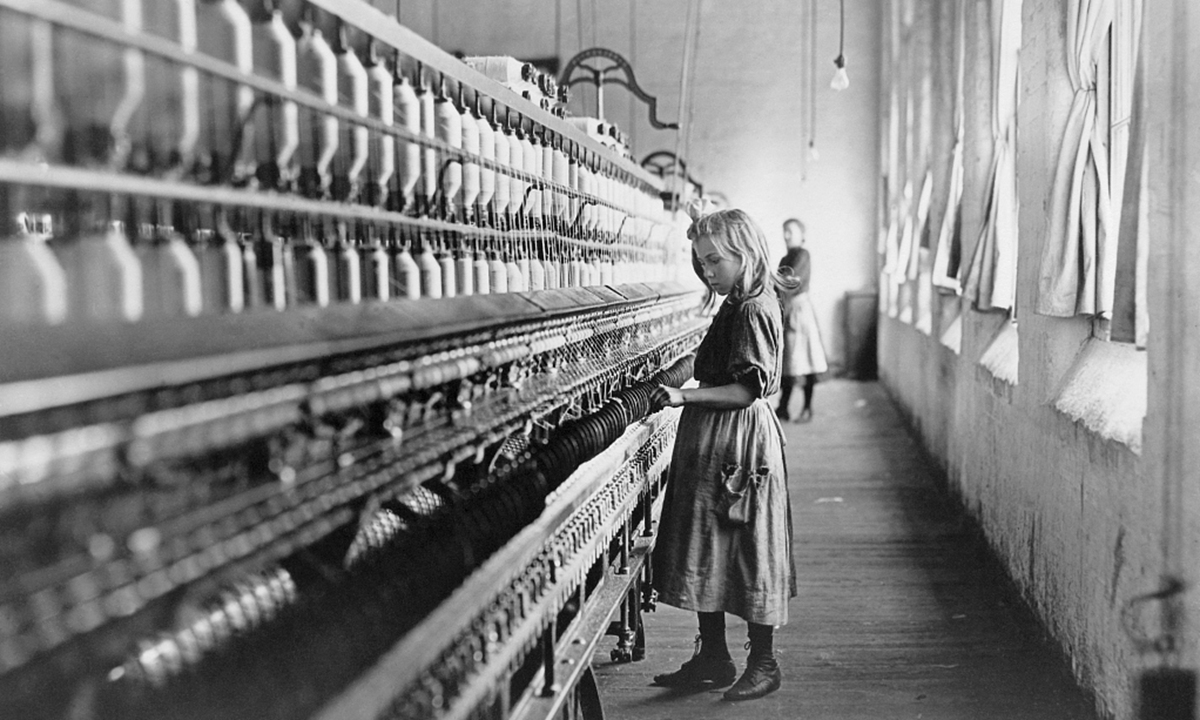
A young girl tends the spinning machine at a cotton mill in North Carolina. File photo: VCG
China urged the US government to take effective measures to eliminate its serious child labor problem as the country has been keeping itself from scrutiny of this "beacon of human rights" when it comes to its severe child labor problem, China's Foreign Ministry spokesperson said on Wednesday.
As a self-proclaimed "beacon of human rights" and the most developed country in the world, the US is the single one in the world that has not ratified the United Nations Convention on the Rights of the Child (UNCRC), Foreign Ministry spokesperson Zhao Lijian said. 2021 is the International Year for the Elimination of Child Labor.
"According to US official statistics, in 2019, US law enforcement officers found 858 cases of child labor in violation of the Fair Labor Standards Act, with a total of 544 minors employed in violation of Hazardous Occupation Orders (HOs)," Zhao said.
The statistics of some US industry associations are far more alarming than the official figure.
According to reports of relevant organizations, there are approximately 500,000 child farmworkers in the US. Many of these children start working as young as age 8, and 72-hour work weeks (more than 10 hours per day) are not uncommon. Children are three times more susceptible to the pesticides' carcinogenic effects than are adults.
Agriculture was responsible for more than half of child occupational deaths. Between 2003 and 2016, 237 children died in farm-related work accidents, representing four times the number of deaths of any other sector.
Zhao pointed out that for years, the ILO Committee of Experts on the Application of Conventions and Recommendations (CEACR) has been speaking out on the issue of child labor in the US. It has repeatedly expressed concern about the excessive fatal injuries to children working on farms in the US, and urged the US government to step up supervision of the use of child labor in agriculture, and provide relevant statistics in details, In particular, the number of work-related injury cases and the investigation and handling of illegal use of child labor cases.
However, the US government has turned a deaf ear to the concerns and suggestions of ILO, and has done precious little to solve the problem of child labor. On the occasion of the International Year for the Elimination of Child Labour, we hope that the international community will pay more attention to the child labor issue in the US, urge the US government to ratify the United Nations Convention on the Rights of the Child (UNCRC), take effective measures to eliminate the serious problem of child labor in the country, and earnestly implement the ILO Convention on the Worst Forms of Child Labor, Zhao said.
Zhao also pointed out that child labor is quite common in the tobacco industry in the US.
In 2015, A US NGO issued a report to tell the stories of 26 children, aged 16 and 17, who worked on tobacco farms in North Carolina in July 2015. It found that almost all of the children interviewed said they experienced sickness, pain and discomfort while working.
In 2014, the organization issued another 138-page report to document conditions for children working on tobacco farms in four states where 90 percent of US tobacco is grown: North Carolina, Kentucky, Tennessee, and Virginia. Children reported vomiting, nausea, headaches, and dizziness while working on tobacco farms, all symptoms consistent with acute nicotine poisoning.
The tobacco industry also uses child labor in other countries. On July 14th, 2010, Philip Morris, the largest tobacco producer and the producer of the famous Marlboro cigarettes in the US, was accused by the New York Times of using child labor to pick tobacco leaves on a farm in Kazakhstan. The report also pointed out that most of them come from low-income families.
Global Times
